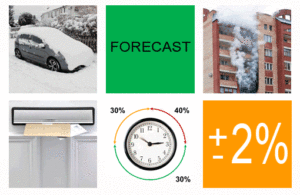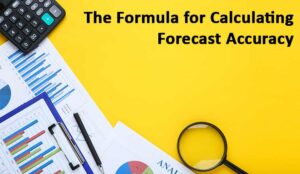Lorraine Kelleher of Spearline introduces us to customer forecasts, before sharing her advice for taking them to the next level.
What Is Customer Forecasting?
Customer forecasting is an important method of anticipating how many customers the business may attract over a specific period of time and the associated revenues that these will generate. It uses historical data as inputs to make well-informed estimates in order to predict future trends.
Forecasting helps organizations to determine how their budget should be allotted in order to achieve their goals. Many businesses invest large amounts of both time and labour into forecasting; however, KPMG highlights that only one in five of these forecasts produce reliable information.
This is a worrying statistic, considering the impact that forecasting can have on the business. The following points are designed to help organizations improve the efficiency and usability of their customer forecasts.
1. Ensure Honest Forecasting
In order to make better decisions when it comes to forecasting, it is essential that business executives instil a culture of honesty and transparency, especially in regard to forecast creation. There can be several reasons for inaccurate forecasts; for example, employees may be over-optimistic and overly ambitious with their targets.
Using previous forecasts as a benchmark for forthcoming forecasts could help to resolve this issue. All sales forecasts should, therefore, be linked to existing sales data. For example, if sales are currently declining, it would be illogical to forecast a sales increase without a significant level of evidence that things are going to improve.
On the other hand, employees may choose to be under-ambitious in their forecasting so that they can ultimately exceed these targets and potentially receive a higher level of reward for surpassing expectations. This is why it is crucial that a culture of honesty and transparency is ingrained within the business. An accurate forecast will retain a neutral outlook – neither overly optimistic or pessimistic.
2. Consult Employees
Communication among staff members and relevant departments prevents forecasts from becoming misunderstood. This is essential to ensure that a high level of coherence is achieved. It is imperative that within a business, the sales team has complete involvement in customer forecasting practices.
These individuals provide the most extensive knowledge of prospective customers and insights into the organization’s sales pipeline and funnel. This includes the average length of time between the generation of a potential sales lead to deal closure and sign-off. Without this essential information, it is nearly impossible to curate an accurate forecast.
The sales team is the individuals who will be designing a sales plan based on the data established within the customer forecast; therefore involving them at this early stage will help to create a more comprehensive, logical link between each. The team will be able to identify if any of the targets within the customer forecast are overly ambitious or unachievable.
It is essential to ensure that employees are aware of the forecast as it can work as a motivational tool by providing the sales team with SMART (Specific, Measurable, Achievable, Realistic, Time-bound) targets that performance can subsequently be measured against.
3. Utilize Consumer Insights
Oftentimes, existing consumers can provide the most valuable insights in regard to customer forecasting. Customers can detail their own expected growth and future spending with a specific company, and this information has the power to enhance the business’s existing sales strategy.
These customers may be capable of pinpointing what factors influenced their decision to work with a certain business over another competitor.
Equally, organizations or individuals who have decided not to work with a business may be able to provide their rationale for this decision, thus creating further knowledge that may not have been readily available to the sales team. These insights can be invaluable when it comes to increasing the number of deals that are closed.
Third-party perceptions and data points can help organizations to increase the accuracy of their customer forecasts.
4. Choose the Correct Forecasting Technique
Those involved in customer forecasting must collectively agree on the best forecasting technique for their specific circumstances. In terms of a technique, neither quantitative or qualitative techniques should be relied on exclusively. A more balanced approach should be used, leveraging all available information.
Opportunity stages forecasting calculates the likelihood of a deal closing. It requires an objective understanding of all stages of the sales pipeline and an extensive sales history in order to extrapolate the information.
This is an excellent method to forecast future revenues while monitoring the sales team’s performance. Forecasting can also be based on the length of an average sales cycle, helping to predict when a deal is most likely to close. This method makes assessments based on the age of the deal.
A series of algorithms can then be created based on various types of deals such as a web-generated lead or a cold call from sales.
Regression analysis is a quantitative form of forecasting with a very strong mathematical focus. It requires an extensive understanding of the statistics for a number of factors that influence the organization’s sales cycle and customer journey.
The relationship between each of these variables is calculated and the influence on the company’s sales performance is determined. Correctly running regressions can expose valuable information about the business and help to enhance future growth.
Scenario writing is a qualitative approach that can be very beneficial when it comes to long-term customer forecasting. The likely outcomes are projected based on a precise set of assumptions.
Several scenarios are drafted subsequent to these assumptions, including the best- and worst-case scenarios for the deals which are in progress at a given moment in time.
Scenario writing can often act in a way similar to a contingency plan. This method requires not only a subjective knowledge of the business itself but also an understanding of the psychology of human behaviours.
While it is important to ensure that organizations do not suffer from “paralysis by analysis”, using multiple methods of customer forecasting can provide a deeper understanding and a more comprehensive picture of what is likely to happen.
Conclusion

Lorraine Kelleher
By creating an accurate customer forecast and curating a sales plan that remains in line with this, businesses can often avoid unforeseen and costly problems that they may have otherwise experienced.
A well-constructed sales plan, combined with in-depth customer forecasting, can allow organizations to spend more time developing the business instead of responding to incremental and menial developments in the sales process.
For more information, visit www.spearline.com
Author: Robyn Coppell
Published On: 7th Feb 2020 - Last modified: 11th Feb 2020
Read more about - Guest Blogs, Spearline















